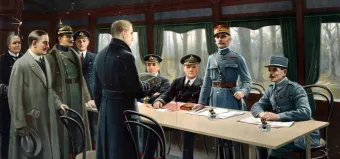Centennial lessons: peace-making since the first world war

Centennial lessons: peace-making since the first world war
November 11 marks the 100th anniversary of the signing of the Armistice on the Western Front, ending the hostilities of the First World War. Representatives of over sixty nations gather in Paris for ceremonies observing this historical milestone.
The signing of the armistice, and the subsequent years negotiating treaties to restore peace in a shattered Europe have been bitterly criticized as flawed, both at the time and since. Many see the origins of the even more devastating Second World War in this process and in the actions of its protagonists. However, these 100 years still yield many lessons for civilian and military decision makers, political leaders, historians and students. The Armistice was a military convention between fighting forces which could not end the war in itself. The optimistic hopes of the German military command to prevent facing defeat and invasion by the Allies could not be matched by the conditions which the victors could impose to press their advantage and bar any resumption of fighting. Furthermore, this original misunderstanding was then reinforced by the unprecedented and direct involvement of the Allied political leaders in the negotiation of the future peace treaties, whose terms would be imposed to the defeated. Each leader brought additional stakes to the negotiations to defend national interests that were legitimate in the eyes of their populations who had sacrificed so much over four years. The ambitious and novel project of forming a “General Association of Nations” to oversee future international relations and collective security could be leveraged against the acceptance by the contracting parties of a single power’s claims. The final form of the Treaty of Versailles and associated agreements naturally reflected this outcome. Idealism certainly introduced new principles and practices in international relations, and it brought about the League of Nations; but it did not, and still does not, sit easily with peace-making processes that necessitate participation of the combatants as well as of the civilian leadership, a capacity to balance redress and justice with magnanimity and future reconciliation, and the careful consideration of practical implementation on the ground.
The peace-making process that began on November 11 1918 amply illustrated the dilemmas that face modern peace-makers even in the case of very different contemporary conflicts from that of 1914-1918. Civilian-military relations are crucial to successful negotiations, and combatant involvement in the process cannot be neglected, if a settlement is to be accepted and durable. The personal investment of top leaders brings authority to a process, but also flawed judgment and domestic political concerns that complicate reaching objectives. While a spur towards the final goal, idealist principles must be balanced with the concrete facts of conflict-hit locations and populations, the history and geography of the fighting.
These past 100 years teach us that ending war is a learning process, and the lessons of historical precedents offer not only mistakes to be avoided but experiences to consider and odds to overcome.
An op-ed by Dr Paul Vallet, GCSP Associate Fellow, Global Fellowship Initiative.
Dr Paul Vallet
VIDEO: Centennial Lessons: Peace-making since the First World War.
Ambassador Jean-Marc Boulgaris
VIDEO: Centennial Lessons: Peace-making since the First World War.
